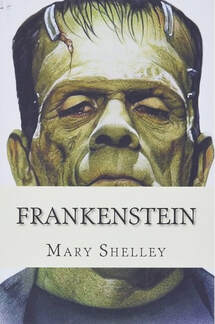|
The Amazon cover for the book features the green classic monster, not as described in the book. Fall is spooky season and one of the main Halloween monsters is of course Frankenstein's monster, sometimes called Adam. Since it is a foundational text to scifi--the very first scifi, in fact--I decided to read the original Frankenstein by Mary Shelley. Rather than review it, I decided to write about what I learned about writing irom this classic novel (or really a novella, it was about 110 pages).
1) Don't be afraid of a unique story structure Frankenstein is actually a letter written by a sea captain to his sister about meeting Dr. Frankenstein and that man's story. So the meat of the book is "story within a story" since you know in the end things will circle back to that boat captain. At one point, the story becomes the monster's story being told to Dr. Frankenstein being told to the captain. Like Russian nesting dolls. However, this complicated structure was made very clear and even acted as foreshadowing of excitement when the start of Dr. Frankenstein's tale got a little dry. 2) Don't overdo the backstory While it may have been the style of the time, modern readers now don't need Dr. Frankenstein's life story to begin with his parents meeting. When I saw that was how the story began, I was dreading the rest. It didn't get interesting until Dr. Frankenstein left for college. So while it's good to read classics, keep in mind how very different the market is today, and don't accidentally pick up on very out of date style choices. 3) Build sympathy by showing what your characters wants most We were all a little afraid of Frankenstein's monster after his first kill, naturally, because he's not on the page much to defend himself. However, he makes it clear exactly what he wants: a lover. He is so intensely lonely and in need of contact that after he explains it, you can't avoid sympathy. There is even some sympathy for Dr. Frankenstein when he just wants to protect others. Get your readers to choose sides by showing a deep want and explaining why--and why they can't have it (yet). 4) Keep up with the latest innovations Mary Shelley was inspired by Galvanism and advances with electricity. If she'd only stayed aware of what was going on in the literary world, she wouldn't have run into the concepts that allowed her to conceive of Frankenstein. When looking for inspiration, look at innovations in fields that excite you: space, medicine, engineering, environmental science, oceanography, etc. Even keeping up with new historical finds in archaeology or anthropology, if you're more of a history/fantasy writer. You never know when you'll run into something that will inspire, so get out of your typical bubble. Those are my big takeaways from Frankenstein for writers. I will admit I was very surprised that a lot of classic Frankenstein tropes weren't in the original book--no castle, no Igor, no villagers with pitchforks and torches. He literally made his monster in his dorm room. (Try explaining that mess to your R.A.) I think he was even described as yellow, not green. So the Hollywood-ization of Frankenstein has clearly overshadowed the original for my entire experience. Kind of wild! Have you read Frankenstein? What were your writing (or reading) takeaways? What are some of your spooky season favorites? Let's discuss in the comments!
0 Comments
Leave a Reply. |
Archives
April 2024
Categories
All
|


 RSS Feed
RSS Feed